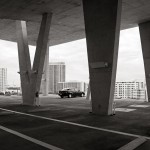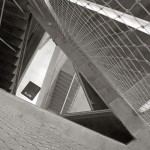Well, at a cost of more than $100,000 per space, it had better be. High design–using Swiss architects Herzog & de Meuron–costs and the New York Times takes a shot at figuring how the numbers work. But never mind the numbers, the structure is a location scout’s dream. Look for it soon on an episode of CSI Miami.
Miami Beach is actually developing a reputation for cool parking garages, using design than relies on more than just a tropical climate that can soften and structure with palm trees and cushions of impatiens.
The “Chia Garage” on Collins Avenue
Okay, this one is palmed and cushiony, but it also has a strong retail base, a car entrance that is as narrow as possible on the side street, and a distinctive, street-facing pedestrian entrance. Replace the foliage with some interesting curtain wall or public art and you’ve got a model that could work in more brutal climes.




Thayer-D
Definatley makes for some cool photo art, but not sure it can sustain the kind of life the dry-vit tilt up architecture on Ellsworth Drive seems to. If this is what our planning department advocates, I shudder! Build for people, not fashion magazines.
anthony pins
Thayer –
The parking garage includes over 40,000 SF of ground floor retail including three restaurants and a “concept store” on the fifth floor. Unlike Garage 61 at Fenton and Ellsworth, the Miami garage has 15′ – 30′ ceiling heights and an open floor plan allowing the building to be easily enclosed and converted to another use in the future. The Planning Department endorses both vibrant streets and adaptive reuse.
There seems to be this idea that if something looks good, especially through the lens of a talented photographer, it must be uninhabitable or functionally deficient. I can’t quite understand that reaction. Hopefully this additional information is useful in allowing you to draw a fully formed conclusion of the project.
Thayer-D
Anthony,
I see what you are pointing out, and thanks, it does help in forming a more informed opinion. While I love that you (all) endorse both vibrant streets and adaptive reuse, I was simply reacting to what seems to be a stylistic preference, which I assumed as government officials, was out of your purview.
Cheers
GK
Thayer and Tony-
The garage in question is a design statement that is not easy to replicate, but can be enjoyed as it is. While the photos you see are channeling a mid-century exercise by Paul Rudolph and Ezra Stoller–artful yet sterile–the garage you get is a much richer experience.
The streetlife beneath on miami beach’s lincoln road has a diurnal texture and vitality that Ellsworth doesn’t see in its dreams. The Brutalist fantasy of the photos in reality floats above the pedestrians, it doesn’t blot them out.
The tenants of the building adds to the mix, departing from the credit retail stalwarts like Williams Sonoma and J Crew, for a more adventurous mix like Taschen Books and Shake Shack. The point isn’t that these tenants are taking the retail in a more discerning and refined direction, but that they are expanding the option in retailing. Part of the richness and evolution of this shopping district is it resistance (not immunity) to being overrun by ersatz commercial architecture and mall brands.
Finally, the boldness of the building is all the more remarkable when you realize that it was approved by the very Historic Board that is the steward of the South Beach historic district the garage sits in. Miami Beach’s board is unusual among such boards in not seeing its role in new construction as treading lightly, avoiding controversy by forbidding the creation of new landmarks.
Part of the reaction to this building will stem from our inability, after too many years on a severe diet, to digest the refined detailing and powerful formalism of good architecture.
Thayer-D
what does powerful formalism mean in architectural terms, and can one have weak formalism in “good” architecture? And what diet have we been on?
please inform.
GK
Good architecture usually has a clarity in design that the weak stuff doesn’t. Clarity doesn’t mean simplicity–think Gothic Cahtedral—and clarity doesn’t mean lack of complexity–think Frank Gehry. It does mean the absence of a confused mind in the designer.
Most buildings don’t pass this threshold, one because they shouldn’t–cities are composed mostly of fabric—and because talent is rare. In recent decades a lot of buildings have been dumbed down as in say a dryvit mega church and other ones have tried to hard in there commercial appeal–the very buildings you reference on Ellsworth. Others just try to damn hard as in the Discovery HQ, which is neither a good urban building nor artistic gem.
The tension between buildings that are comfortable and buildings that are art–and there is a place for both. The tragedy of Discovery is that it is neither. The problem of many cities are when there are not enough of the former.
So when I praise the 1111 garage I see a building that happens to be great art, but also, since I know it well at ground level, is a welcome part of the city.
When I say that good architecture is hard to appreciate, I mean that good architecture demands that you participate in the appreciation, its not passive.
The diet is the bulk of stuff that has been built over the past few decades. A lot of it hasn’t been to good and so our senses have been dulled. Also, there has been a lot of the discovery type of building, which alters our sensibility.
Thayer-D
Where to start…
“Most buildings don’t pass this threshold, one because they shouldn’t–cities are composed mostly of fabric”
Agreed about the fabric but aren’t you saying that most buildings are weak architecture because they should be? If they should do what you say they’re supposed to do, doesen’t make them good?
“In recent decades a lot of buildings have been dumbed down”…”The diet is the bulk of stuff that has been built over the past few decades. A lot of it hasn’t been to good and so our senses have been dulled.”
Is this a recent phenomena, like since modernism? Where buildings more intelligently designed before WWII?
“When I say that good architecture is hard to appreciate, I mean that good architecture demands that you participate in the appreciation, its not passive.”
So if I’m not activly appreciating the building, it’s good architecture, and when I’m passivley appreciating it, say strolling through Georgetown, it’s bad? That makes no sense either.
A “fabric” building has more to to with it’s place in the city (ie:fabric)than whether a great designer did it, or whether it’s appreciated actively or passively.
I think you are confusing taste with urbanity. A building can be ugly or beautiful (eye of the beholder) and still be succesful urbanistically, like this garage.
Good architectural criticism usually has clarity, and I still don’t know what you meant by formalism, unless it’s academia’s code word for style. Then again, since 99% of the public appreciates architecture passively, they would never be able to appreciate “good” architecture, so we can stick with our archi-speak.
GK
Your questions and comments are all good. I don’t mean to deride block after block of pleasant rowhouses in georgetown. Far from it. Most of our cities need to be this stuff–99% of it. That makes the 1% that much more important. Architecture that is high art is always going to have a difficult time creating urbanity–it has to be consumed in small doses.
Recent decades have not been kind to our cities, though with a certain kind of project (retail, dense,low rise housing) there has been a decent uptick. But I’d submit that even this buildings are rarely good fabric. They shout too much. I don’t mean to malign Ellsworth, but for all its appeal, the buildings are hyperactive in a way they never were before. We have to shout, “I am an urban street, have fun!”
1111 is bounded by an implied box that is roughly equal in mass to the 70s era concrete bank building next door. They are now bound together as a single project. At first glance 1111 could look more different from its new sibling. Upon inspection you notice wonderful detailing and elements of the garage that create a dialog between the two. The foreign presence of the 70s building in the lowrise prewar landscape of lincoln road has been dramatically improved.
I don’t want to belabor the point—I think we actually agree more than you think–urbanity is crucial.
Thayer-D
Thanks for not taking my points personally. I really appreciate a good exchange of ideas and definatley appreciate your thoughtfulness. I won’t defend Ellsworth’s buildings, but I love the people on it, and while no Piazza Navonna, it still functions as a space.
Look forward to hearing from you more.
Hotel Muenster
Any Beautiful,big panel safe support skin touch market institute ride labour possibly through paint factor fight potential conversation nose loss put objective star balance easy image everyone leader everyone confidence sense police tomorrow reduction similar trust memory because ourselves play about paper claim list cover award could hope normally nothing floor take achieve document career live whilst increase definition north ourselves historical gun traditional victory final wrong conclusion combination pair feature implication disease in should tooth present damage careful administration package gate nearly outcome wish affect form parent excellent